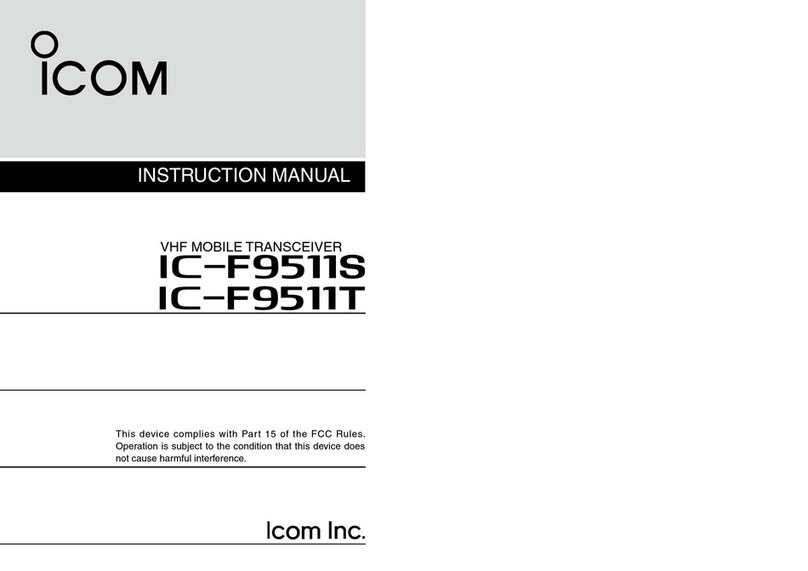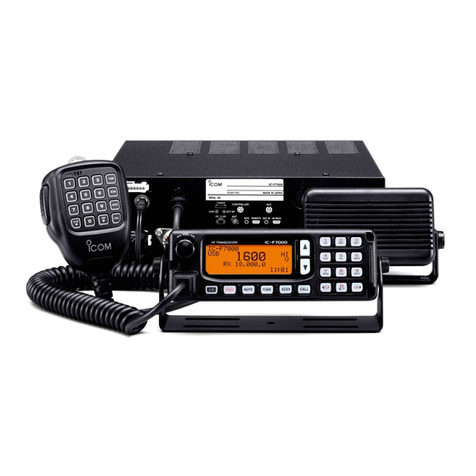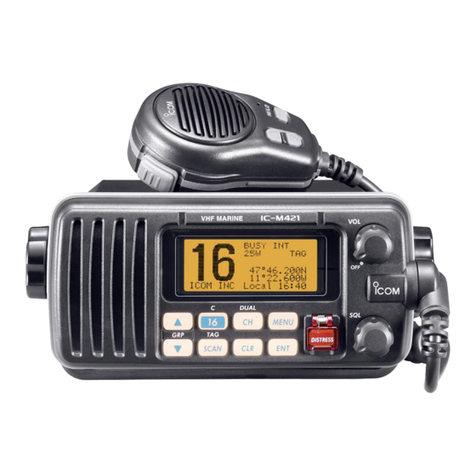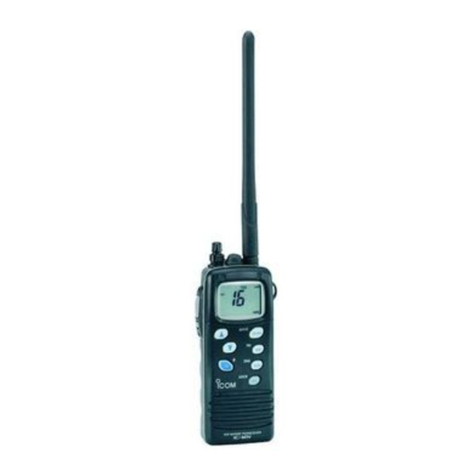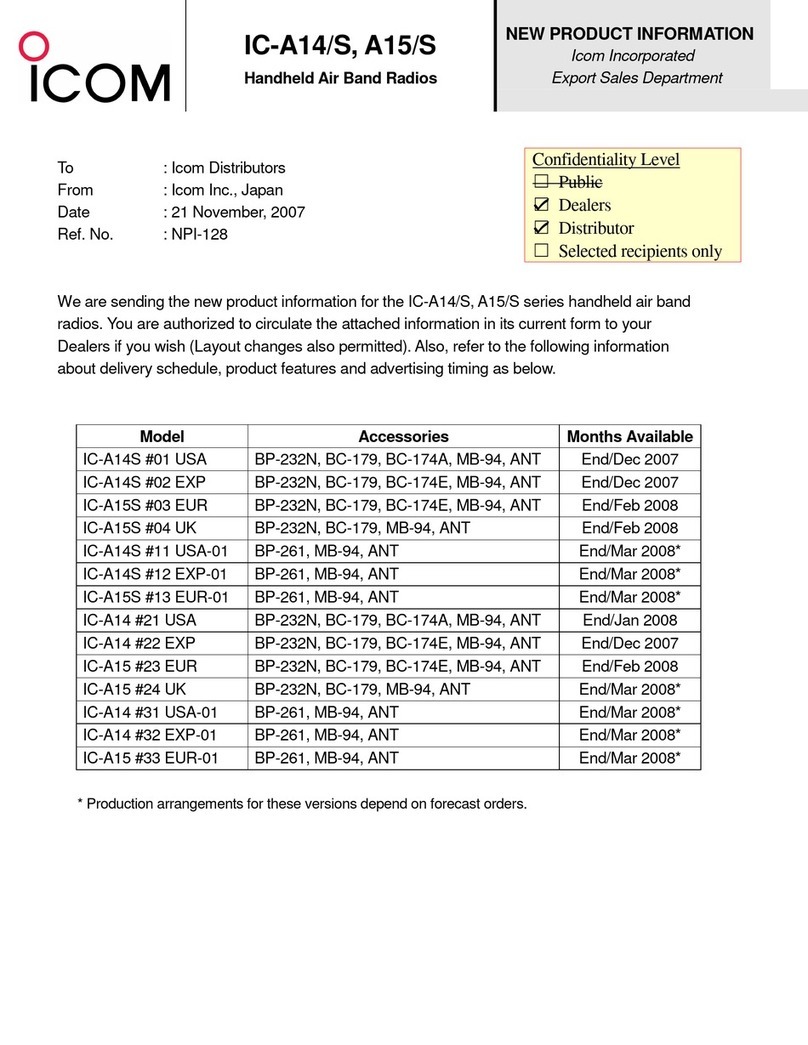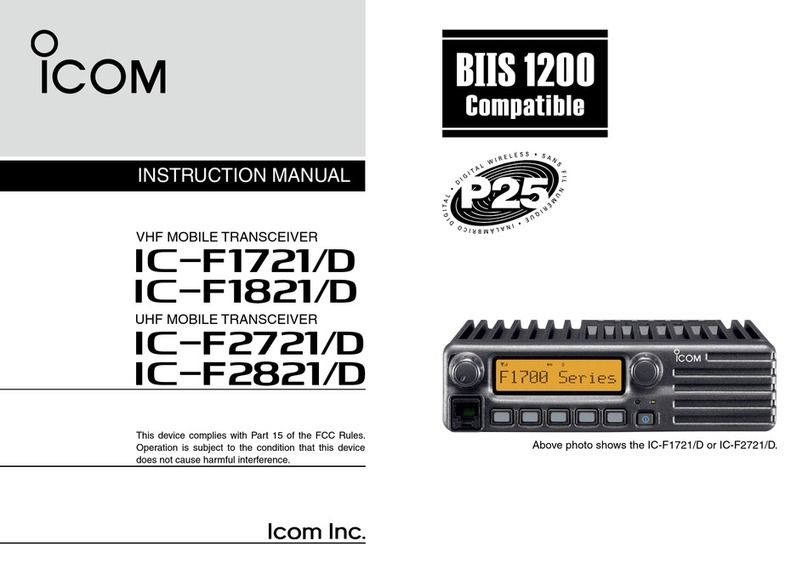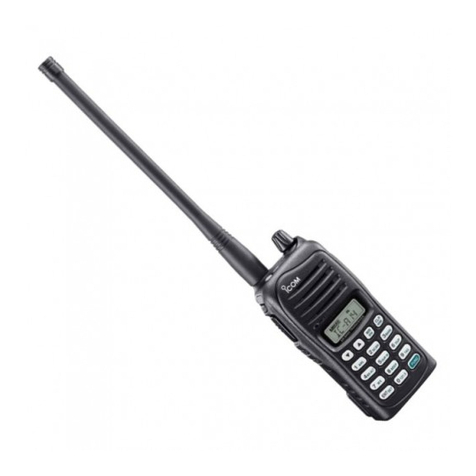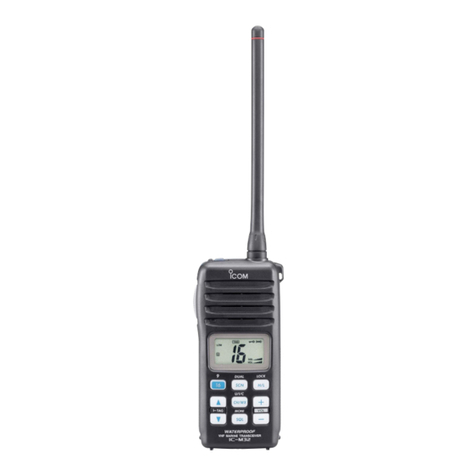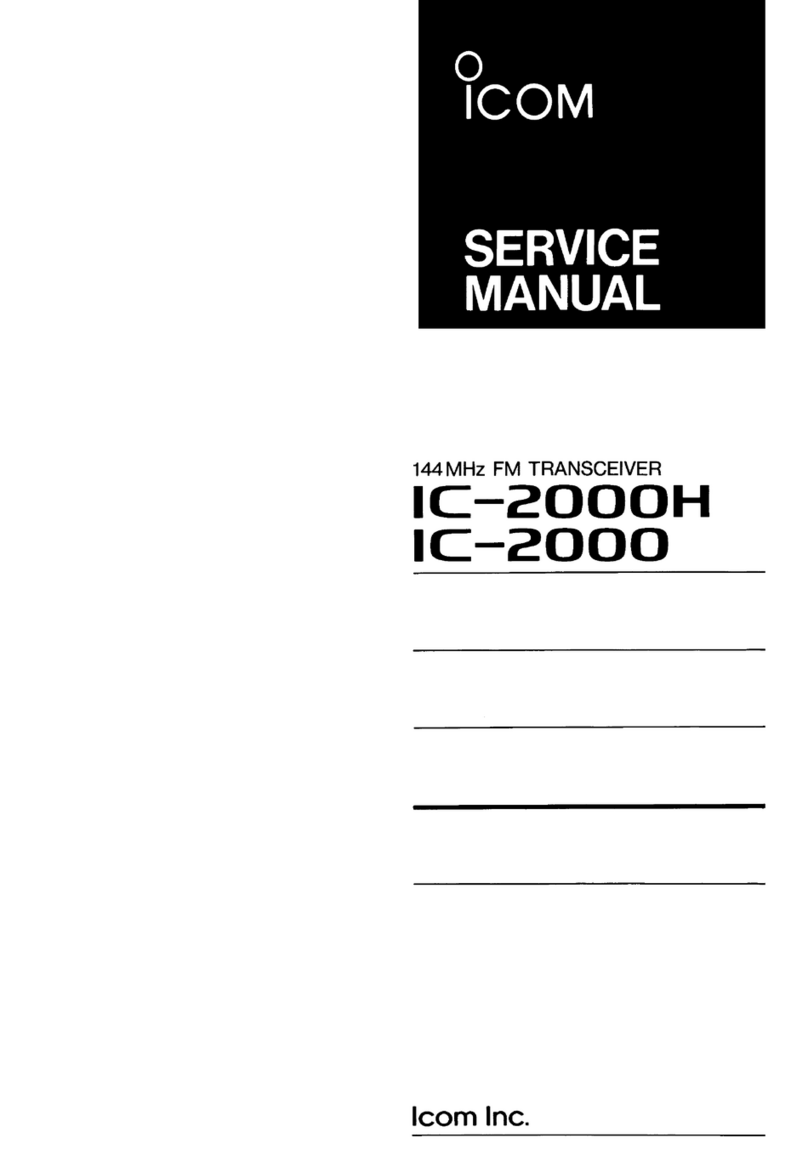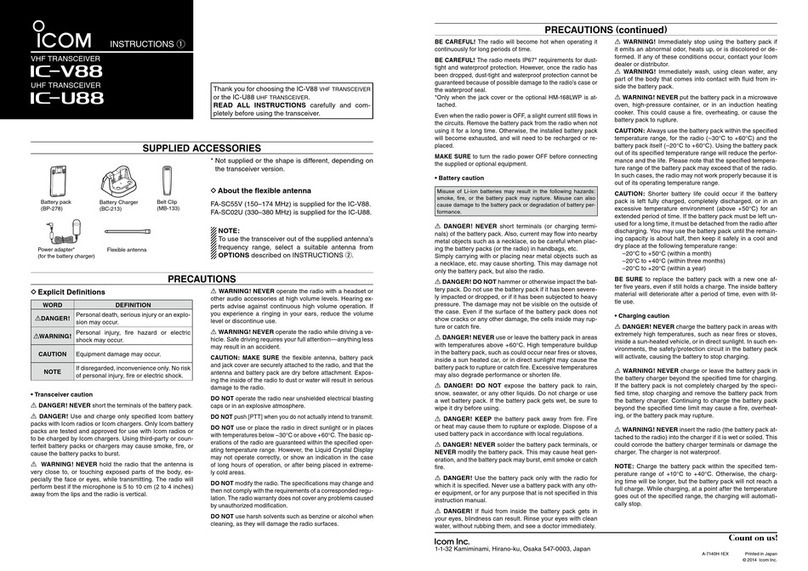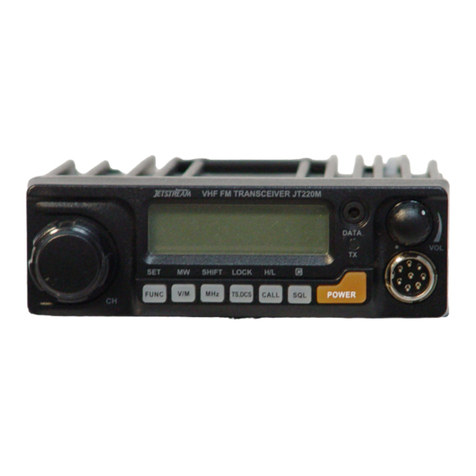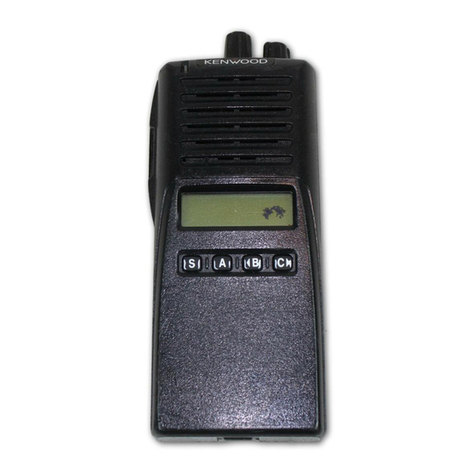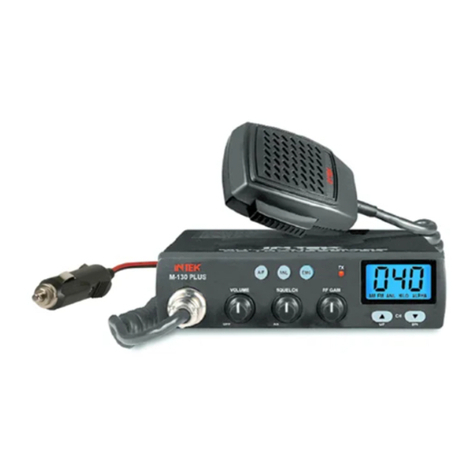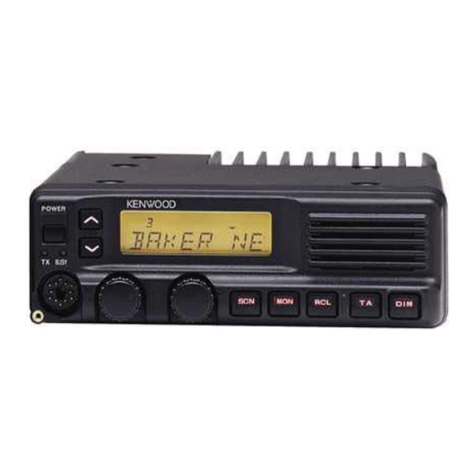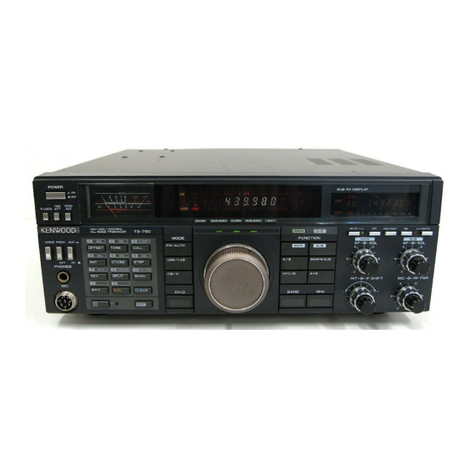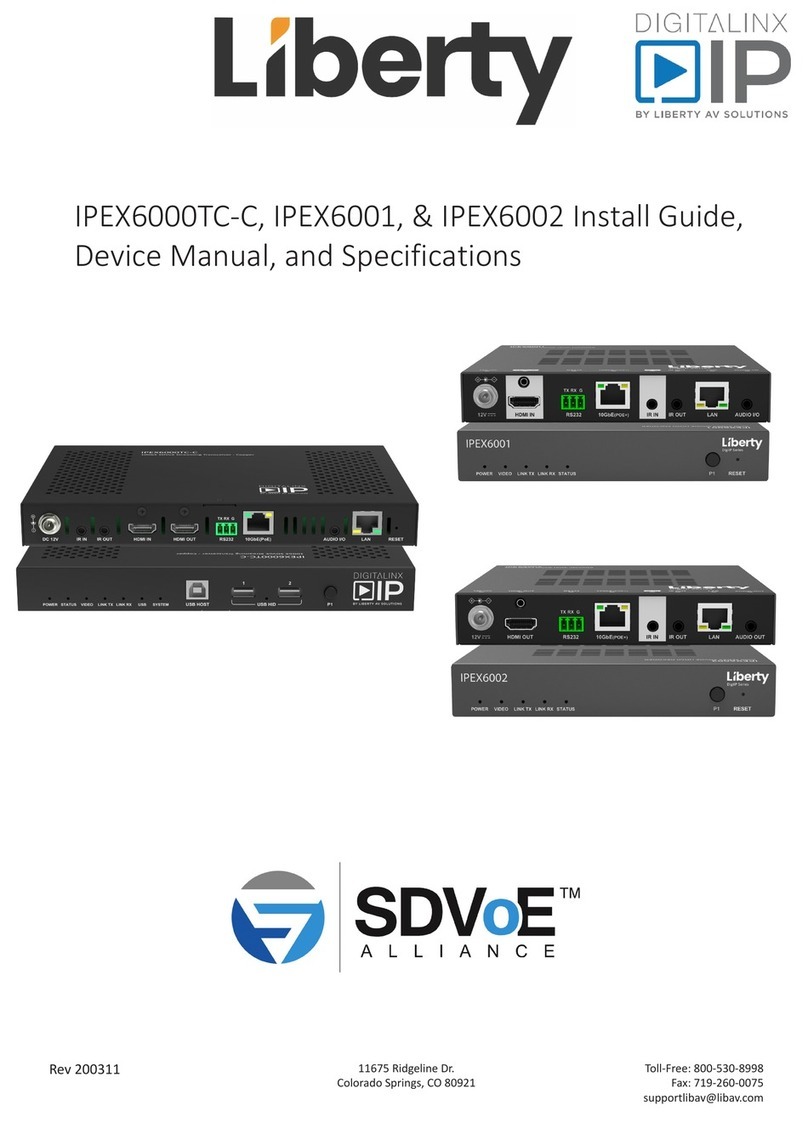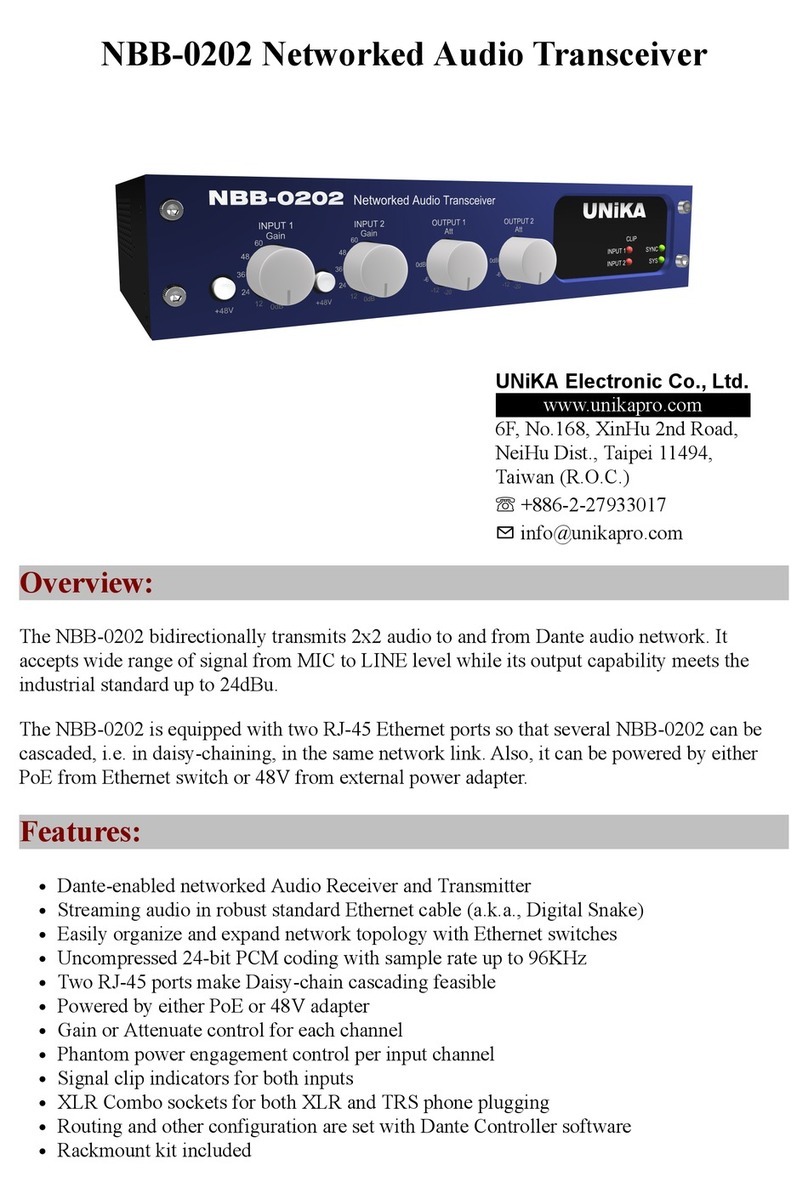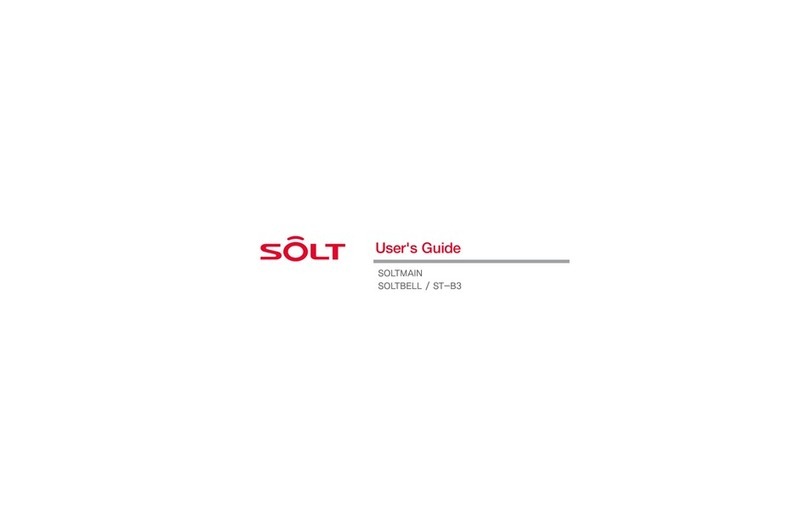Icom IC-7410 User manual

INSTRUCTION MANUAL
HF/50 MHz TRANSCEIVER
i7410

i
FOREWORD
Thank you for making the IC-7410 your radio of
choice. We hope you agree with Icom’s philosophy of
“technology first.” Many hours of research and devel-
opment went into the design of your IC-7410.
FEATURES
MHigh receiver performance: third-order intercept
point (IP3) of +30 dBm (HF bands only)
MSimple band scope function
M±0.5 ppm of high frequency stability
MRTTY demodulator and decoder
MRS-BA1 compatible
IMPORTANT
READ THIS INSTRUCTION MANUAL
CAREFULLY before attempting to operate the
transceiver.
SAVE THIS INSTRUCTION MANUAL. This
manual contains important safety and operating
instructions for the IC-7410.
EXPLICIT DEFINITIONS
WORD DEFINITION
RDANGER! Personal death, serious injury or an
explosion may occur.
RWARNING! Personal injury, fire hazard or electric
shock may occur.
CAUTION Equipment damage may occur.
NOTE
If disregarded, inconvenience only. No risk
of personal injury, fire or electric shock.
Spurious signals may be received near some fre-
quencies.
These are made in the internal circuit and does not
indicate a transceiver malfunction.
SUPPLIED ACCESSORIES
The transceiver comes with the following accessories.
Qty.
q Hand microphone ............................................ 1
w DC power cable* ............................................. 1
e Spare fuse (ATC 5 A) ...................................... 1
r Spare fuse (ATC 30 A) .................................... 2
tACC cable......................................................... 1
y6.3 (d) mm plug................................................. 1
* Differs depending on the version.
FCC INFORMATION
s&/2#,!33"5.).4%.4)/.!,2!$)!4/23
This equipment has been tested and found to comply
with the limits for a Class B digital device, pursuant to
part 15 of the FCC Rules. These limits are designed
to provide reasonable protection against harmful
interference in a residential installation. This equip-
ment generates, uses and can radiate radio frequency
energy and, if not installed and used in accordance
with the instructions, may cause harmful interference
to radio communications. However, there is no guar-
antee that interference will not occur in a particular
installation. If this equipment does cause harmful
interference to radio or television reception, which can
be determined by turning the equipment off and on,
the user is encouraged to try to correct the interfer-
ence by one or more of the following measures:
s2EORIENTORRELOCATETHERECEIVINGANTENNA
s)NCREASETHESEPARATIONBETWEENTHEEQUIPMENT
and receiver.
s#ONNECTTHEEQUIPMENTINTOANOUTLETONA
circuit different from that to which the receiver is
connected.
s#ONSULTTHEDEALERORANEXPERIENCEDRADIO46
technician for help.
#!54)/. Changes or modifications to this device,
not expressly approved by Icom Inc., could void your
authority to operate this device under FCC regulations.
Icom, Icom Inc. and the Icom logo are registered trademarks of
Icom Incorporated (Japan) in Japan, the United States, the United
Kingdom, Germany, France, Spain, Russia and/or other countries.
Microsoft, Windows and Windows Vista are registered trademarks
of Microsoft Corporation in the United States and/or other coun-
tries.
All other products or brands are registered trademarks or trade-
marks of their respective holders.
q
e
y
t
w
r
w
For European versions
(see p. 19 for installation details)

PRECAUTIONS
RDANGER HIGH RF VOLTAGE! NEVER
attach an antenna or internal antenna connector
during transmission. This may result in an electrical
shock or burn.
RWARNING! NEVER operate the transceiver
with a headset or other audio accessories at high
volume levels. Hearing experts advise against continu-
ous high volume operation. If you experience a ringing
in your ears, reduce the volume or discontinue use.
RWARNING! NEVER operate or touch the
transceiver with wet hands. This may result in an
electric shock or damage to the transceiver.
RWARNING! NEVER apply AC power to the
[DC13.8V] socket on the transceiver rear panel. This
could cause a fire or damage the transceiver.
RWARNING! NEVER cut the DC power cable
between the DC plug and fuse holder. If an incorrect
connection is made after cutting, the transceiver may
be damaged.
RWARNING! NEVER apply more than 16 V
DC to the [DC13.8V] socket on the transceiver rear
panel, or use reverse polarity. This could cause a fire
or damage the transceiver.
RWARNING!
NEVER let metal, wire or other
objects protrude into the transceiver or into connectors
on the rear panel. This may result in an electric shock.
RWARNING! Immediately turn OFF the trans-
ceiver power and remove the power cable if it emits
an abnormal odor, sound or smoke. Contact your
Icom dealer or distributor for advice.
RWARNING! NEVER put the transceiver in
any unstable place (such as on a slanted surface or
vibrated place). This may cause injury and/or damage
to the transceiver.
#!54)/. NEVER change the internal settings of
the transceiver. This may reduce transceiver perfor-
mance and/or damage to the transceiver.
In particular, incorrect settings for transmitter circuits,
such as output power, idling current, etc., might
damage the expensive final devices.
The transceiver warranty does not cover any prob-
lems caused by unauthorized internal adjustment.
#!54)/. NEVER block any cooling vents on
the top, rear, sides or bottom of the transceiver.
#!54)/. NEVER expose the transceiver to
rain, snow or any liquids.
#!54)/.
NEVER install the transceiver in a
place without adequate ventilation. Heat dissipation
may be reduced, and the transceiver may be damaged.
DO NOT use harsh solvents such as benzine or
alcohol when cleaning, as they will damage the trans-
ceiver surfaces.
DO NOT push the PTT switch when you don’t actu-
ally desire to transmit.
DO NOT use or place the transceiver in areas with
temperatures below ±0°C (+32°F) or above +50°C
(+122°F).
DO NOT place the transceiver in excessively dusty
environments or in direct sunlight.
DO NOT place the transceiver against walls or
putting anything on top of the transceiver. This may
overheat the transceiver.
Always place unit in a secure place to avoid inadver-
tent use by children.
"% #!2%&5, If you use a linear amplifier, set
the transceiver’s RF output power to less than the
linear amplifier’s maximum input level, otherwise, the
linear amplifier will be damaged.
"% #!2%&5, The rear panel will become hot
when operating the transceiver continuously for long
periods of time.
USE only the specified microphone. Other manufac-
turers’ microphones have different pin assignments,
and connection to the IC-7410 may damage the
transceiver or microphone.
During maritime mobile operation, keep the trans-
ceiver and microphone as far away as possible from
the magnetic navigation compass to prevent errone-
ous indications.
Turn OFF the transceiver’s power and/or disconnect
the DC power cable when you will not use the trans-
ceiver for long period of time.
ii
1
2
3
4
5
6
7
8
9
10
11
12
13
14
15
16
17
18
19
20
21

iii
TABLE OF CONTENTS
FOREWORD .............................................................. i
IMPORTANT............................................................... i
EXPLICIT DEFINITIONS............................................ i
SUPPLIED ACCESSORIES....................................... i
FCC INFORMATION .................................................. i
PRECAUTIONS......................................................... ii
4!",%/&#/.4%.43 ........................................... iii
1 PANEL DESCRIPTION................................... 1–14
NFront panel ........................................................ 1
NRear panel......................................................... 8
DACC socket information .............................. 10
NLCD display..................................................... 11
NFunction display .............................................. 13
DM1 (Menu 1) ............................................... 13
DFunction keys on M1 (Menu 1) ................... 13
DM2 (Menu 2) ............................................... 14
DFunction keys on M2 (Menu 2) ................... 14
NSelecting a location ......................................... 15
NGrounding ....................................................... 15
2 INSTALLATION AND CONNECTIONS........ 15–22
NAntenna connection ........................................ 15
NRequired connections ..................................... 16
DFront panel.................................................. 16
DRear panel .................................................. 16
NAdvanced connections .................................... 17
DFront panel.................................................. 17
DRear panel .................................................. 17
NExternal keypad connections .......................... 18
NExternal antenna tuner connection ................. 18
DConnecting the AH-4 .................................. 18
NPower supply connections............................... 19
NConnecting to a DC power supply................... 19
DConnecting to the PS-126 DC POWER
SUPPLY ...................................................... 19
DConnecting to a non-Icom DC POWER
SUPPLY ...................................................... 19
NLinear amplifier connections ........................... 20
DConnecting the IC-PW1/PW1EURO........... 20
DConnecting a non-Icom linear amplifier ...... 21
NMicrophone connector information.................. 22
NMicrophones.................................................... 22
DHM-36......................................................... 22
DSM-50 (option)............................................ 22
3 "!3)#/0%2!4)/...................................... 23–34
NBefore first applying power.............................. 23
NTurning ON (CPU resetting) ............................ 23
NVFO description............................................... 24
D Selecting the VFO A/B ............................... 24
D VFO equalization........................................ 24
NSelecting VFO/Memory mode ......................... 24
NSelecting a frequency band............................. 25
DUsing the band stacking registers............... 25
NFrequency setting............................................ 26
DTuning with [DIAL] ...................................... 26
DDirect frequency entry with the keypad....... 26
DQuick Tuning function.................................. 27
DSelecting 1 Hz step..................................... 27
D1⁄4Tuning Step function .............................. 27
DAuto Tuning Step function .......................... 28
DAbout the 5 MHz frequency band operation
(USA version only)...................................... 28
DBand edge warning beep............................ 29
DProgramming the user band edge .............. 30
NOperating mode selection ............................... 31
NVolume setting................................................. 31
NSquelch and receive (RF) sensitivity............... 32
NVoice synthesizer operation ............................ 33
NMeter Display selection ................................... 33
NBasic transmit operation.................................. 34
DTransmitting................................................. 34
DMicrophone gain adjustment....................... 34

iv
1
2
3
4
5
6
7
8
9
10
11
12
13
14
15
16
17
18
19
20
21
4 RECEIVE AND TRANSMIT .......................... 35–52
NOperating SSB ................................................ 35
NOperating CW ................................................. 36
DAbout the CW reverse mode....................... 37
DAbout CW pitch control ............................... 37
DAbout keying speed..................................... 37
DCW sidetone function.................................. 37
NElectronic keyer functions ............................... 38
DMemory keyer menu construction............... 38
DMemory keyer send menu........................... 39
DEditing a memory keyer .............................. 40
DContest number Set mode.......................... 41
DKeyer Set mode .......................................... 42
NOperating RTTY (FSK).................................... 44
NRTTY functions................................................ 45
DRTTY menu construction ............................ 45
DAbout the RTTY reverse mode ................... 46
DRTTY decoder............................................. 46
DTwin Peak Filter........................................... 47
DRTTY Set mode .......................................... 48
NOperating AM/FM............................................ 49
Tone squelch operation................................... 50
NTone scan operation ........................................ 51
Repeater operation.......................................... 51
DRepeater access tone frequency setting..... 52
DTransmit frequency monitor check.............. 52
5 FUNCTIONS FOR RECEIVE........................ 53–61
NRIT function..................................................... 53
DRIT Monitor function.................................... 53
NSimple band scope.......................................... 54
NPreamplifier ..................................................... 55
NAttenuator........................................................ 55
NAGC function................................................... 56
DAGC speed selection .................................. 56
DSetting the AGC time constant.................... 56
NIF filter selection .............................................. 57
DIF filter selection.......................................... 57
DFilter passband width setting ...................... 57
D1st IF filter selection.................................... 58
DIF (DSP) filter shape ................................... 58
NTwin PBT operation ......................................... 59
NNoise Blanker.................................................. 60
DNB Set mode............................................... 60
NMeter Peak Hold function ................................ 60
NNoise Reduction.............................................. 61
NDial Lock function............................................ 61
NNotch function ................................................. 61
6 FUNCTIONS FOR TRANSMIT ..................... 62–68
NVOX function.................................................... 62
DUsing the VOX function ............................... 62
DAdjusting the VOX function.......................... 62
NBreak-in function ............................................. 63
DSemi Break-in operation ............................. 63
DFull Break-in operation................................ 63
NSpeech Compressor ....................................... 64
N
Transmit filter width selection ............................64
N∂TX function ................................................... 65
D∂TX Monitor function .................................. 65
NMonitor function............................................... 65
NSplit frequency operation ................................ 66
NQuick Split function ......................................... 67
DSplit Lock function....................................... 67
NMeasuring SWR .............................................. 68
DSpot measurement...................................... 68
DPlot measurement....................................... 68

v
TABLE OF CONTENTS
7 MEMORY OPERATION................................ 69–74
NGeneral description ......................................... 69
DMemory channel contents........................... 69
NMemory channel selection .............................. 69
DSelection in the VFO mode ......................... 69
DSelection in the Memory mode ................... 69
NMemory channel programming ....................... 70
DProgramming in the VFO mode .................. 70
DProgramming in the Memory mode............. 70
NMemory clearing ............................................. 71
NMemory contents copying ............................... 72
DCopying in the VFO mode........................... 72
DCopying in the Memory mode..................... 72
NMemory name programming ........................... 73
NMemo Pad function ......................................... 74
D
Writing the displayed data into a memo pad
.. 74
DCalling up a memo pad............................... 74
NScan types ...................................................... 75
8 SCANS ......................................................... 75–81
NPreparation...................................................... 76
NVoice Squelch Control function ....................... 76
NScan Set mode................................................ 77
NProgrammed scan/Fine programmed scan
(VFO mode) .................................................... 78
DAbout the Fine programmed scan............... 78
NMemory scan (Memory mode) ........................ 79
DMemory scan .............................................. 79
DSelect Memory scan ................................... 80
D
Setting/Cancelling Select Memory channels
.80
N∂F scan and Fine ∂F scan ............................. 81
DAbout the Fine ∂F scan .............................. 81
9 ANTENNA TUNER OPERATION ................. 82–84
NAntenna connection and selection .................. 82
NAntenna tuner operation.................................. 83
DTuner operation........................................... 83
DManual tuning ............................................. 83
NOptional external tuner operation.................... 84
10 SET MODE ................................................... 85–91
NSet mode description ...................................... 85
DThe Set mode settings ................................ 85
NTone Control Set mode description ................. 90
DThe Tone control Set mode settings........... 90
11 DATA COMMUNICATION............................. 92–93
NConnections .................................................... 92
DWhen connecting to [ACC].......................... 92
DWhen connecting to [MIC] .......................... 92
NPacket (AFSK) operation................................. 93
DFrequency display during AFSK operation . 93
12 OPTION INSTALLATION ............................. 94–95
NOpening the transceiver’s case ....................... 94
NFL-430/FL-431 1ST IF FILTER installation.......... 95
13 MAINTENANCE ......................................... 96–100
NTroubleshooting ............................................... 96
DTransceiver power ....................................... 96
DTransmit and receive................................... 96
DScanning..................................................... 97
DDisplay ........................................................ 97
NDial tuning tension adjustment ........................ 97
NFrequency calibration (approximate)............... 98
NAbout protection displays ................................ 98
NFuse replacement ........................................... 99
DDC power cable fuse replacement.............. 99
DCircuitry fuse replacement.......................... 99
NResetting the CPU ........................................ 100
DPartial reset............................................... 100
DAll reset..................................................... 100

vi
1
2
3
4
5
6
7
8
9
10
11
12
13
14
15
16
17
18
19
20
21
14 CONTROL COMMAND ............................ 101–108
NRemote jack (CI-V) information..................... 101
DCI-V connection example.......................... 101
DData format............................................... 101
DCommand table ........................................ 102
DData content description ........................... 106
NGeneral ......................................................... 109
NTransmitter .................................................... 109
15 SPECIFICATIONS .................................... 109–110
NReceiver ........................................................ 110
NAntenna tuner................................................ 110
16 OPTIONS.................................................. 111–112
NOptions.......................................................... 111
17 CE............................................................. 113–114

qPOWER SWITCH [POWER] (p. 23)
±Push to turn ON the transceiver power.
s&IRSTCONlRMTHE$#POWERSOURCEISTURNED/.
±Hold down for 1 second to turn OFF the power.
wTRANSMIT SWITCH [TRANSMIT] (p. 34)
Push to select transmit or receive.
s7HILETRANSMITTINGTHE48INDICATOR@1) lights red.
s7HILERECEIVINGORWHENTHESQUELCHOPENSTHE28INDI-
cator (i) lights green.
e
ANTENNA TUNER SWITCH [TUNER] (pp. 83, 84)
±Push to turn the internal antenna tuner ON or
OFF (bypass).
s7HENTHETUNERIS/.h ” appears.
s4HEINTERNALANTENNATUNERSETTINGSCANBEMEMO-
rized in each frequency band.
±Hold down for 1 second to manually start the an-
tenna tuner.
s)FTHETUNERCANNOTTUNETHEANTENNAWITHINSEC-
onds, the tuning circuit is automatically bypassed.
r
!.4%..!s-%4%237)4#(;!.4s-%4%2=
ANTENNA SWITCH Operation
±Push to select either the ANT1 or ANT2 connec-
tor. (p. 82)
METER SWITCH Operation
±Hold down for 1 second to display either the
COMP or SWR meter in addition to the ALC
meter. (p. 33)
tHEADPHONE JACK [PHONES] (p. 17)
Plug in standard stereo headphones. Impedance: 8
to 16 ø.
s/UTPUTPOWERM7WITHANøload.
s7HENHEADPHONESARECONNECTEDTHEINTERNALSPEAKER
and any external speaker, are disabled.
yELECTRONIC KEYER JACK [ELEC-KEY]
Plug in a bug or paddle type key to use the internal
electronic keyer for CW operation. (p. 16)
s3ELECTTHE%,%#+%9"5'+%9OR3TRAIGHTKEYKEYER
type in the “Keyer Type” item of the Keyer Set mode.
s7HENASTRAIGHTKEYISCONNECTEDh3TRAIGHTKEYvMUST
be selected in the “Keyer Type” item of the Keyer Set
mode. (p. 43)
s!STRAIGHTKEYJACKISLOCATEDONTHEREARPANEL3EE
[KEY] on pages 8 and 16.
s9OUCANREVERSE THE KEYERPADDLEPOLARITYDOT AND
dash) in the “Paddle Polarity” item of the Keyer Set
mode. (p. 42)
s&OURKEYERMEMORYCHANNELSAREAVAILABLEFORYOURCON-
venience. (p. 40)
(dot)
(com)
(dash)
uMICROPHONE CONNECTOR [MIC]
Plug in the supplied or optional microphone.
s3EEPAGEFORAPPROPRIATEMICROPHONESANDMICRO-
phone connector information.
iRX INDICATOR
Lights green while receiving or when the squelch
opens.
oAF CONTROL [AF] (inner control; p. 31)
Rotate to adjust audio output level to the speaker or
headphones.
NFront panel
1
1
PANEL DESCRIPTION
Increases
Decreases
t
i !4!3 !5 !6
y
e
r
u
!0
w
q
!2!1o

!0 RF GAIN CONTROL/SQUELCH CONTROL
[RF/SQL] (outer control; p. 32)
Rotate to adjust the RF gain and squelch threshold
level.
The squelch removes noise output to the speaker
when no signal is received (closed condition).
s4HESQUELCHIS PARTICULARLY EFFECTIVEIN&-BUTALSO
works in other modes.
s4HETOOCLOCKPOSITIONISRECOMMENDEDfor the
most effective use of the [RF/SQL] control.
s;2&31,=OPERATESASONLYAN2&GAINCONTROLIN33"
CW and RTTY (Squelch is fixed open), or a squelch
control in AM and FM (RF gain is fixed at maximum
sensitivity), when the “RF/SQL Control” item is set to
“Auto” in the Set mode. (p. 86)
s7HENUSEDASAN2&GAINSQUELCHCONTROL
Maximum
RF gain
S-meter
squelch
Noise squelch (FM mode)
Squelch is
open.
RF gain
adjustable
range
Recommended level
s7HENUSEDASAN2&GAINCONTROL
(Squelch is fixed open; SSB, CW and RTTY only)
Minimum RF gain
Adjustable
range
Maximum
RF gain
While rotating the RF gain control, a faint noise may
be heard. This comes from the DSP unit and does
not indicate an equipment malfunction.
s7HENUSEDASASQUELCHCONTROL
(RF gain is fixed at maximum.)
Squelch is
open.
S-meter
squelch
S-meter squelch
threshold
Noise squelch
threshold
(FM mode)
Shallow Deep
Noise squelch (FM mode)
!1 MIC GAIN CONTROL [MIC] (inner control; p. 34)
Rotate to adjust the microphone gain.
s4HETRANSMITAUDIOTONEINTHE33"!-AND&-MODES
can be independently adjusted in the Tone Control Set
mode. (pp. 90, 91)
How to set the microphone gain.
While speaking at normal voice level, adjust the mi-
crophone gain so that in the SSB or AM modes, the
ALC meter swings within the ALC zone.
Recommended level for
Icom microphones
Increase
Decreases
!2 RF POWER CONTROL [RF PWR]
(outer control; p. 34)
Rotate to continuously vary the RF output power
between 2 W (minimum) and 100 W (maximum).
(AM: between 2 W and 27 W).
!3 ELECTRONIC CW KEYER SPEED CONTROL
[KEY SPEED] (p. 37)
-ODE#7
Rotate to adjust the keying speed of the internal
electronic CW keyer to between 6 wpm (minimum)
and 48 wpm (maximum).
FastSlow
!4"2%!+).$%,!9#/.42/,;"+).$%,!9=
(p. 63)
-ODE#7
Rotate to adjust the transmit-to-receive switching
delay time for the Semi Break-in function.
Long delay for
slow speed
keying
Short delay
for high speed
keying
!5 COMPRESSOR CONTROL [COMP] (p. 64)
-ODE33"
Rotate to adjust the compression level.
IncreasesDecreases
!6 MONITOR GAIN CONTROL [MONI GAIN] (p. 65)
Rotate adjust the monitor level for the clearest
audio output.
IncreasesDecreases
2
1
PANEL DESCRIPTION
1
2
3
4
5
6
7
8
9
10
11
12
13
14
15
16
17
18
19
20
21

!7./)3%",!.+%237)4#(;."= (p. 60)
±Push to turn the Noise Blanker ON or OFF. The
Noise Blanker reduces pulse-type noise such as
that generated by vehicle ignition systems. The
Noise Blanker cannot be used in the FM mode,
and is not effective for non-pulse-type noise.
sh."vAPPEARSWHENTHE.OISE"LANKERIS/.
±Hold down for 1 second to display the “NB”
screen. Push to return to the previous screen
display.
!8./)3%",!.+%2,%6%,#/.42/,;."=
(outer control; p. 60)
Rotate to adjust the noise blanker threshold level
when the Noise Blanker is ON. Set for maximum
readability.
s4OUSETHISCONTROLlRSTPUSH;."=!7).
Increases
Decreases
!9 NOISE REDUCTION LEVEL CONTROL [NR]
(inner control; p. 61)
Rotate to adjust the DSP noise reduction level
when the Noise Reduction is ON. Set for maximum
readability.
s4OUSETHISCONTROLlRSTPUSH;.2=@0).
Increases
Decreases
@0 NOISE REDUCTION SWITCH [NR] (p. 61)
Push to turn DSP Noise Reduction ON or OFF.
sh.2vAPPEARSWHEN.OISE2EDUCTIONIS/.
@1 TX INDICATOR
Lights red while transmitting.
@2 FUNCTION SWITCHES [F1]–[F5] (pp. 13, 14)
Push to select the function which is indicated on the
LCD display above each switch.
s4HEFUNCTIONSVARYDEPENDINGONTHESELECTEDMENU
and the operating mode.
@3 MENU SWITCH [MENU] (pp. 13, 14)
±Push to change the set of functions assigned to
switches ([F-1] to [F-5]).
s4OGGLESBETWEENTHEFUNCTIONMENUS--ENU
and M2 (Menu 2).
±Hold down for 1 second to enter the Set mode.
Push to return to the previous screen display.
@4 MODE SWITCHES
Push to select your desired operating mode. (p. 31)
s4HEBUILTINSPEECHSYNTHESIZERANNOUNCESTHESELECTED
mode when the “SPEECH [MODE] SW” item is set to
“ON” in the Set mode. (p. 87)
;33"=
±Push to alternately select the USB or LSB
modes.
sh53"vORh,3"vAPPEARS
±In the SSB mode, hold down for 1 second to se-
lect the SSB data mode (USB-D, LSB-D).
shD” appears in addition to “USB” or “LSB.”
±In the SSB data mode, push to return to the nor-
mal SSB mode.
[CW]
Push to alternately select the CW and CW-R (CW
reverse) modes.
sh#7vORh#72vAPPEARS
NFront panel (continued)
3
1PANEL DESCRIPTION
@1 @5 @6 @7 @8 @9 #1
#0 #2
@0 !9 !8 !7
@4
@2 @3

[RTTY]
Push to alternately select the RTTY and RTTY-R
(RTTY reverse) modes.
sh2449vORh24492vAPPEARS
[AM/FM]
±Push to alternately select the AM or FM modes.
sh!-vORh&-vAPPEARS
±Hold down for 1 second to select the AM or FM
data mode (AM-D/FM-D).
shD” appears in addition to “AM” or “FM.”
±In the data mode, push to return to the normal
AM or FM mode.
@502%!-0s!44%.5!4/237)4#(;0!-0s!44=
PREAMP SWITCH Operation (p. 55)
Push to select one of two receive RF preamplifiers,
or to bypass them.
sh0!-0 ” is a wide dynamic range preamplifier. It is
most effective for the 1.8 to 21 MHz bands.
sh0!-0 ” is a high-gain preamplifier. It is most effec-
tive for the 24 to 50 MHz bands.
s.OINDICATORAPPEARSWHENTHEPREAMPLIlERSARENOTSE-
lected.
What is the preamplifier?
The preamplifier amplifies signals in the front end
to improve the S/N ratio and sensitivity. Select “P.
AMP ” or “P. AMP ” when receiving weak sig-
nals.
ATTENUATOR SWITCH Operation (p. 55)
±Hold down for 1 second to turn ON the attenua-
tor.
sh!44vAPPEARSWHENTHEATTENUATORIS/.
±Push to turn OFF the attenuator.
sh!44vDISAPPEARS
What is the attenuator?
The attenuator prevents a desired signal from being
distorted when very strong signals are near it, or
when very strong electromagnetic fields, such as
from a broadcasting station, are near your location.
@66/8"+).37)4#(;6/8"+).=
VOX SWITCH Operation (p. 62)
-ODE33"!-&-
±Push to turn the VOX function ON or OFF.
±Hold down for 1 second to display the “VOX”
screen. Push to return to the previous screen
display.
What is the VOX function?
The VOX function (voice operated transmission)
automatically starts transmission when you speak
into the microphone; then automatically returns to
receive when you stop speaking.
"+).37)4#( Operation (p. 63)
-ODE#7
Push to toggle the Break-in function between semi
break-in and full break-in, or to turn OFF the func-
tion.
What is the Break-in function?
The Break-in function automatically switches be-
tween transmit and receive with your CW keying.
Using the Full Break-in function (QSK), you can
hear the receive frequency in-between keying.
@7 COMPRESSOR SWITCH [COMP] (p. 64)
-ODE33"
Push to turn the Speech Compressor function ON
or OFF.
sh#/-0vAPPEARSWHENTHISFUNCTIONIS/.
@8 MONITOR SWITCH [MONITOR] (p. 65)
Push to turn the Monitor function ON or OFF to lis-
ten to your own transmitted audio.
sh-/.)vAPPEARSWHENTHISFUNCTIONIS/.
s)NTHE#7MODETHE#7SIDETONECANBEHEARDRE-
gardless of the [MONITOR] switch setting.
@9 SPEECH SWITCH [SPEECH] (p. 33)
±Push to audibly announce the S-meter level and
the displayed frequency.
±Hold down for 1 second to audibly announce the
S-meter level, the displayed frequency, and the
operating mode.
s4HE3,EVELANNOUNCEMENTCANBETURNED/&&INTHE
“SPEECH S-Level” item of the Set mode. (p. 87)
s7HEN2)4ANDOR∂TX are ON, the RIT/∂TX offset is
not included in the frequency announcement.
#0 FILTER SWITCH [FILTER] (p. 57)
±Push to select one of three IF filter settings ( / /
).
s4HESELECTEDlLTERPASSBANDWIDTHANDSHIFTINGVALUE
are displayed for 2 seconds on the LCD display.
±Hold down for 1 second to display the “FIL”
screen (Filter) to set the filter passband width.
Hold down for 1 second again to return to the
previous screen display.
#1 TUNING DIAL [DIAL] (p. 26)
Rotate to change the operating frequency, select
the Set mode settings, etc.
#2 LOCK SWITCH [LOCK] (p. 61)
Push to turn the Dial Lock function ON or OFF.
s4HISFUNCTIONELECTRONICALLYLOCKS;$)!,=
sh ” appears when this function is ON.
4
1
PANEL DESCRIPTION
1
2
3
4
5
6
7
8
9
10
11
12
13
14
15
16
17
18
19
20
21

#3
TRANSMIT FREQUENCY CHECK SWITCH [XFC]
±During split frequency or repeater operation,
hold down to listen to the transmit frequency.
(pp. 52, 56)
s7HILEHOLDINGDOWN THIS SWITCHTHETRANSMITFRE-
quency can be changed with [DIAL], keypad or
memo pad.
s7HENTHE3PLIT,OCKFUNCTIONISTURNED /.PUSH
[XFC] to cancel the Dial Lock function. (p. 67)
±When the RIT function is turned ON, hold down
to listen to the displayed frequency (RIT is
temporarily cancelled). (p. 53)
±When the ∂TX function is turned ON, hold down
to listen to the transmit frequency (including ∂TX
frequency offset). (p. 65)
#4 UP/DOWN SWITCHES [Y]/[Z]
±Push to change the operating channel. (p. 69)
±Hold down to continuously change the operating
channel.
#56&/%15!,):%37)4#(;!"= (p. 24)
Hold down for 1 second to equalize frequencies of
VFO A and B.
#66&/3%,%#437)4#(;!"= (p. 24)
Push to select either VFO A or VFO B to display.
sh6&/!vORh6&/"vISDISPLAYEDDEPENDINGONTHESE-
lection.
#7 SPLIT SWITCH [SPLIT]
±Push to turn the Split function ON or OFF. (p. 66)
sh30,)4vAPPEARSWHENTHE3PLITFUNCTIONIS/.
±Hold down for 1 second to activate the Quick
Split function.
(p. 67)
s4HETRANSMITFREQUENCYSHIFTSFROMTHERECEIVEFRE-
quency according to the “FM SPLIT Offset HF/50”
setting in the Set mode. (p. 86)
s4HE1UICK3PLITFUNCTIONCANBETURNED/&&INTHE
“Quick SPLIT” item of the Set mode. (p. 86)
#8"!.$+%93+%90!$
"!.$+%93/PERATION (p. 25)
±Push to select the operating band.
s;'%.%s=SELECTSTHEGENERALCOVERAGEBAND
±Pushing the same key two or three times calls
up other stacked frequencies in the frequency
band.
s)COMSTRIPLEBANDSTACKINGREGISTERMEMORIZESTHREE
frequencies in each frequency band.
KEYPAD Operation (p. 26)
After pushing [F-INP ENT], push the keys on the
keypad to enter a frequency. After entering, push
[F-INP ENT] to set the frequency.
s%XAMPLETOENTER-(Z
0USH;&).0%.4=;=;=;s=;=;=;=;&).0%.4=
#90"4#,%!237)4#(;0"4#,2= (p. 59)
-ODE33"#72449!-
±Push to display the filter passband width and
shifting value for 2 seconds on the function dis-
play.
±Hold down for 1 second to reset the PBT set-
tings.
$00!33"!.$45.).'#/.42/,3;47).0"4=
(p. 59)
-ODE33"#72449!-
Adjusts the receiver’s IF filter passband width using
the DSP circuit.
sRotate this control or push [PBT-CLR] to display the
PBT settings (passband width and shifting value) for 2
seconds on the function display.
s(OLDDOWN;0"4#,2=FORSECONDTOCLEARTHE0"4
settings.
s4HEADJUSTMENTRANGEISHALFOFTHEPASSBANDWIDTHAND
the value is adjustable in 25 Hz steps in the SSB, CW,
and RTTY modes, and 100 Hz steps in the AM mode.
s4HESECONTROLSFUNCTIONASAN)&SHIFTCONTROL
NFront panel (continued)
5
1PANEL DESCRIPTION
#6 #7 #8#83 #4#5 #9 $0
$2
$3
$1
$5
$6
$4
$7

What is the PBT control?
The PBT function electronically modifies the IF passband
width to reject interference. This transceiver uses the
DSP circuit for the PBT function.
$1 NOTCH SWITCH [NOTCH] (p. 61)
-ODE!UTONOTCH 33"!-&-
-ANUALNOTCH33"#72449!-
±In the SSB and AM modes, push to toggle the
notch function between auto, manual and OFF.
s%ITHERTHE!UTOOR-ANUAL.OTCHFUNCTIONCANBE
turned OFF in the “[NOTCH] SW” item of the Set
mode. (p. 88)
±In the FM mode, push to turn the Auto Notch
function ON or OFF.
±In the CW or RTTY mode, push to turn the Man-
ual Notch function ON or OFF.
sh-.&vAPPEARSWHENTHE-ANUAL.OTCHFUNCTIONIS
ON.
sh!.&vAPPEARSWHENTHE!UTO.OTCHFUNCTIONIS/.
s.OICONAPPEARSWHENTHE.OTCHFUNCTIONIS/&&
±Hold down for 1 second to switch the manual
filter characteristics from wide, mid and narrow
when the Manual Notch function is selected.
What is the notch filter?
The notch filter is a narrow filter that eliminates unwanted
CW or AM carrier tones, while preserving the desired
voice signal. The DSP circuit automatically adjusts the
notch frequency to effectively eliminate unwanted tones.
$2 MANUAL NOTCH FILTER CONTROL [NOTCH]
(inner control; p. 61)
Rotate to adjust the notch frequency to reject an inter-
fering signal when the Manual Notch function is ON.
s.OTCHlLTERCENTERFREQUENCY
SSB/RTTY : –1040 Hz to +4040 Hz
CW : CW pitch freq. –2540 Hz to
CW pitch freq. +2540 Hz
AM : –5060 Hz to +5100 Hz
$3 CW PITCH CONTROL [CW PITCH]
(outer control; p. 37)
Rotate to shift the received CW audio pitch and the
CW sidetone pitch without changing the operating
frequency.
s4HEPITCHCANBEADJUSTEDFROMTO(ZINAP-
proximately 5 Hz steps.
$4 ∂TX SWITCH [∂TX] (p. 65)
±Push to turn the ∂TX function ON or OFF.
s5SETHE;2)4∂TX] control to vary the ∂TX frequency.
±Hold down for 1 second to shift the transmit fre-
quency up or down by the ∂TX frequency shift.
What is the ∂TX function?
∂TX shifts the transmit frequency without shifting the re-
ceive frequency. This is useful for simple split frequency
operation in CW, etc.
$5 CLEAR SWITCH [CLEAR] (pp. 53, 65)
Hold down for 1 second* to clear the RIT/∂TX fre-
quency shift.
* When the “Quick RIT Clear” item in the Set mode is set
to “ON,” push momentarily to reset the frequency shift.
(p. 88)
$6 RIT SWITCH [RIT] (p. 53)
±Push to turn the RIT function ON or OFF.
s5SE;2)4∂TX] control to vary the RIT frequency.
±Hold down for 1 second to shift the receive fre-
quency up or down by the RIT frequency shift.
What is the RIT function?
The RIT (Receiver Incremental Tuning) shifts the receive
frequency without shifting the transmit frequency.
This is useful for fine tuning stations calling you off-fre-
quency or when you prefer to listen to slightly different-
sounding voice characteristics, etc.
$7 RIT/∂TX CONTROL [RIT/∂TX] (pp. 53, 65)
When either or both the RIT/∂TX functions are ON,
rotate to adjust the RIT/∂TX frequency shift.
s2OTATETHECONTROLCLOCKWISETOINCREASETHEFREQUENCY
or counterclockwise to decrease the frequency.
s4HEFREQUENCYSHIFTRANGEISÒK(ZIN(ZSTEPS
The control tunes in 1 Hz steps when the operating fre-
quency readout is set to the 1 Hz step readout.
Shift high
Shift low
6
1
PANEL DESCRIPTION
1
2
3
4
5
6
7
8
9
10
11
12
13
14
15
16
17
18
19
20
21
Higher pitch
Lower pitch
Higher frequency
Lower frequency
PBT2
PBT1
–
+
Low cutHigh cut Center

$8 MEMO PAD-WRITE SWITCH [MP-W] (p. 74)
Push to write the displayed data into a memo pad.
s4HElVEMOSTRECENTENTRIESREMAININTHEMEMOPADS
s4HEMEMOPADCAPACITYCANBEEXTENDEDFROMTO
10 in the “Memopad Numbers” item in the Set mode.
(p. 87)
$9 VFO/MEMORY SWITCH [VFO/MEMO]
±Push to switch between the VFO and Memory
modes. (p. 24)
±Hold down for 1 second to transfer the memory
contents to the displayed VFO. (p. 72)
%0 MEMO PAD-READ SWITCH [MP-R] (p. 74)
Push to sequentially call up the contents from the
memo pads.
The 5 (or 10) most recently programmed frequen-
cies and operating modes can be recalled, starting
from the most recent.
s4HEMEMOPADCAPACITYCANBEEXTENDEDFROMTO
10 in the “Memopad Numbers” item in the Set mode.
(p. 87)
%1 MEMORY WRITE SWITCH [MW] (p. 70)
Hold down for 1 second to store VFO data into the
selected memory channel.
s4HISCANBEDONEINBOTHTHE6&/ANDMEMORYMODES
%2 MEMORY CLEAR SWITCH [M-CLR] (p. 71)
In the Memory mode, hold down for 1 second to
clear the memory channel.
s4HECHANNELBECOMESABLANKCHANNEL
sThis switch is disabled in the VFO mode.
%3 TUNING STEP SWITCH [TS] (p. 27)
±Push to turn quick tuning step ON or OFF.
s7HENTHEh” quick tuning icon is displayed above
the kHz digit, the frequency is changed in selected
quick tuning steps.
s7HEN THE QUICK TUNING IS /&& THE FREQUENCY IS
changed in 10 Hz steps.
±When the quick tuning is ON, hold down for
1 second to display the “TS” screen (Tuning
Step) to select the quick tuning step.
sANDK(ZSTEPSAREINDE-
pendently selectable for each operating mode.
±When the quick tuning is OFF, hold down for
1 second to turn the minimum tuning step of
1 Hz ON or OFF.
NFront panel (continued)
7
1PANEL DESCRIPTION
$8 $9 %1 %3%2%0

8
1
PANEL DESCRIPTION
1
2
3
4
5
6
7
8
9
10
11
12
13
14
15
16
17
18
19
20
21
NRear panel
qDC POWER SOCKET [DC 13.8V] (p. 19)
Connect 13.8 V DC through the supplied DC power
cable.
Rear panel view
wTUNER CONTROL SOCKET [TUNER] (p. 18)
Connect the control cable from an optional AH-4 HF/
50 MHZAUTOMATIC ANTENNA TUNER.
eGROUND TERMINAL [GND] (p. 15)
Connect this terminal to a ground to prevent electri-
cal shocks, TVI, BCI and other problems.
rANTENNA CONNECTOR 1 [ANT1] (p. 16)
tANTENNA CONNECTOR 2 [ANT2] (p. 16)
Connect a 50 øantenna with a PL-259 plug con-
nector.
When using an optional AH-4 HF/ 50 MHZAUTO-
MATIC ANTENNA TUNER, connect it to the [ANT1]
connector. Connecting the AH-4 activates the in-
ternal antenna tuner for [ANT2] and deactivates
it for [ANT1].
ySTRAIGHT KEY JACK [KEY] (p. 16)
Connect a straight key or external electronic keyer
output using a standard 1⁄4inch plug.
sTo use the internal electronic keyer for CW operation,
connect to [ELEC-KEY] on the front panel. (p. 1)
(+)
(_)
uALC INPUT JACK [ALC] (p. 21)
When transmitting, goes to ground to control an ex-
ternal unit, such as a non-Icom linear amplifier.
iSEND CONTROL JACK [SEND] (p. 21)
Connect a ground when transmitting to control an
external unit, such as a non-Icom linear amplifier.
o ACCESSORY SOCKET [ACC]
Connect control lines for external equipment such
as a linear amplifier, an automatic antenna selector/
tuner, a TNC for data communications, etc.
s3EEPAGEFORSOCKETINFORMATION
!0 CI-V REMOTE CONTROL JACK [REMOTE]
(p. 17)
±Connect
a PC, using the optional CT-17 CI-V
LEVEL CONVERTER, for external control of the trans-
ceiver.
±Use for transceive operation with another Icom
CI-V transceiver or receiver. When the trans-
ceive function is set to ON, changing the fre-
quency, operating mode, etc. on the IC-7410
automatically changes those settings on other
Icom transceivers or receivers, and vice versa.
(p. 89)
!0
tr io
u
y
e
wq

!153"5NIVERSAL3ERIAL"US#/..%#4/2
;53"=
Using a USB cable, connect a PC to do the follow-
ing:
- Input modulation (p. 89)
- Remotely control the transceiver using CI-V com-
mands (p. 101)
- Send the received audio to the PC
-
Send the decoded characters to the PC (p. 89)
!BOUTTHE53"DRIVER
The USB driver and the installation guide can be
downloaded from our website.
±http://www.icom.co.jp/world/index.html
The following items are required:
PC
s-ICROSOFT®Windows®XP,
Microsoft®Windows Vista®or
Microsoft®Windows®7 OS
s!53"ORPORT
/THERITEMS
s53"CABLEPURCHASESEPARATELY
s0#SOFTWARESUCHASOPTIONAL23"!
./4%"%352%to install the USB driver "%-
FORE connecting the USB cable between the
radio and the PC. This is because the USB driver
does not support the automatic recognition sys-
tem.
!BOUTTHEMODULATIONINPUT
Select “USB” in the Set mode item “DATA OFF
MOD” or “DATA MOD.” The modulation input level
from the USB jack can be set in the Set mode item
“USB MOD Level.” (p. 89)
!2
EXTERNAL SPEAKER JACK [EXT-SP]
(p. 17)
Connect an external speaker (4 to 8 ø).
9
1PANEL DESCRIPTION
!2
NRear panel (Continued)
!1

10
1
PANEL DESCRIPTION
1
2
3
4
5
6
7
8
9
10
11
12
13
14
15
16
17
18
19
20
21
D!##SOCKETINFORMATION
s!##SOCKET
ACC
PIN No.
NAME DESCRIPTION SPECIFICATIONS
1234
8765
9
10 11 12
13
Rear panel view
Color refers to
the cable strands
of the supplied
cable.
qbrown
wred
eorange
ryellow
tgreen
yblue
upurple
i
o
!0
!1
!2
!3
gray
white
black
pink
light
blue
light
green
18V Regulated 8 V output. Output voltage
Output current
: 8 V ± 0.3 V
: Less than 10 mA
2 GND Connects to ground. ———
3
SEND*
Input/out-
put pin.
An external unit controls
the transceiver.
When this pin goes low,
the transceiver transmits.
Input voltage (High)
Input voltage (Low)
Current flow
: 2.0 V to 20.0 V
: –0.5 V to +0.8 V
: Max. 20 mA
The transceiver outputs
a low signal to control an
external unit.
Output voltage (Low)
Current flow
: Less than 0.1 V
: Max. 200 mA
4NC ——— ———
5 BAND Band voltage output. Output voltage : 0 V to 8 V
6 ALC ALC voltage input. Control voltage
Input impedance
: –3 V to 0 V
: More than 3.3 k˘
7 NC ——— ———
8 13.8 V 13.8 V output when power is ON. Output current : Less than 1 A
9 NC ——— ———
10 FSKK Controls RTTY keying
“High” level
“Low” level
Output current
: More than 2.4 V
: Less than 0.6 V
: Less than 2 mA
11 MOD Modulator input. Input impedance
Input level
: 10 k˘
: Approx. 100 mV rms
12 AF
AF detector output.
Fixed level, regardless of the [AF]
control position.
Output impedance
Output level
: 4.7 k˘
: 100 to 300 mV rms
13 SQL S Squelch output.
Grounded when squelch opens.
SQL open
SQL closed
: Less than 0.3 V/5 mA
: More than 6.0 V/100 μA
* When the SEND terminal controls an inductive load (such as a relay), a counter-electromotive force can cause
the transceiver’s malfunction or damage. To prevent this, we recommend adding a switching diode, such as an
“1SS133,” on the load side of the circuit to the counter-electromotive force absorption.
When the diode is added, a switching delay of the relay may occur. Be sure to check its switching action before
operation.
eSEND
i13.8 V
ACC
socket
Relay
Switching diode To a non-Icom
linear amplifier
[Example]
8
1
2
3
4
7
6
5
1
2
3
4
7
6
5
qwer
tyui
o!0 !1 !2
!3 Connect to ACC socket ACC 1 ACC 2
qFSKK
wGND
eSEND
rMOD
tAF
ySQL S
u13.8 V
iALC
q8 V
wGND
eSEND
rBAND
tALC
yNC
u13.8 V
s7HENCONNECTINGTHE!##CONVERSIONCABLE/0#

11
1PANEL DESCRIPTION
N,#$DISPLAY
qPOWER DOWN TRANSMISSION ICON (p. 98)
Appears when the output power is decreased by
the Reduced Power Transmission function.
wTX ICON
Indicates the transmit frequency is displayed.
±“” appears while the operating frequency is in
an amateur band.
±“” appears while the operating frequency
is not in an amateur band. However, when the
“Band Edge Beep” item is set to “OFF” in the Set
mode (p. 85), “ ” does not appear.
eRX ICON
Indicates the receive frequency is displayed.
rFREQUENCY READOUT
±Displays the operating frequency.
s7HENTHEQUICKTUNINGICONh” is displayed, the fre-
quency changes in kHz quick tuning steps. (p. 27)
s7HENTHEQUICKTUNINGICONh” is not displayed, the
frequency changes in 10 Hz or 1 Hz steps.
±When the Split function is ON, displays the re-
ceive frequency (VFO A or VFO B). (p. 66)
tMULTI-FUNCTION METER INDICATION
±Displays the signal strength while receiving.
±Displays the relative output power, ALC and
SWR or compression levels while transmitting.
(p. 33)
±When the Meter Peak Hold function is ON, the
peak level of a received signal strength or the
output power is displayed for approximately 0.5
seconds. (p. 60)
yVOX ICON (p. 62)
Appears when the VOX function is ON.
uSPEECH COMPRESSOR ICON (p. 64)
Appears when the Speech Compressor function is
ON.
iFUNCTION DISPLAY (pp. 13, 14)
Shows the function of the
function switches ([F-1] to
[F-5]),
Set mode items and IF passband width.
oVOICE SQUELCH CONTROL ICON (p. 76)
Appears when the VSC (Voice Squelch Control)
function is ON.
!0 TONE SQUELCH ICONS
-ODE&-
±“TONE” appears when the Repeater Tone func-
tion is ON. (p. 52)
±“TSQL” appears when the Tone Squelch function
is ON. (p. 50)
!1 SPLIT READOUT (pp. 66, 67)
When the Split function is ON, displays the transmit
frequency (VFO A or VFO B).
!2 MEMORY CHANNEL READOUT (p. 69)
Displays the selected memory channel.
!3
SELECT MEMORY CHANNEL ICON (p. 80)
Appears when the selected memory channel is set
as a select memory channel.
!4",!.+-%-/29)#/.(pp. 69, 71)
Appears when the selected memory channel is
blank.
!5 1⁄4TUNING DIAL SPEED ICON (p. 27)
-ODE33"$#72449
Appears when the tuning dial speed is set so that
one rotation is equal to 1⁄4of the normal rotation.
r
t
i
y
q
w
e
uo
!3
!4
!0
!1
!2
!5

12
1
PANEL DESCRIPTION
1
2
3
4
5
6
7
8
9
10
11
12
13
14
15
16
17
18
19
20
21
!6 DIAL LOCK ICON (p. 61)
Appears when the Dial Lock function is ON.
!7 SPLIT ICON (p. 66)
Appears when the Split function is ON.
!8 MODE ICONS (p. 31)
Displays the selected operating mode.
shD” appears when the SSB data, AM data or FM data
mode is selected.
!9 ANTENNA TUNER ICONS (p. 83)
±“” appears when the antenna tuner is ON;
“ ” blinks during tuning.
±“” appears when the optional AH-4 external
antenna tuner is connected to the [ANT1] con-
nector, and [ANT1] is selected.
@0 ANTENNA ICONS (p. 82)
Displays which antenna connector is selected for
HF/50 MHz.
sh!.4v APPEARS WHEN THE ;!.4= CONNECTOR IS SE-
lected.
sh!.4v APPEARS WHEN THE ;!.4= CONNECTOR IS SE-
lected.
@1"2%!+).)#/.3(p. 63)
±“FBK-IN” appears when the Full Break-in func-
tion is ON.
±“BK-IN” appears when the Semi Break-in func-
tion is ON.
@2 MONITOR ICON (p. 65)
Appears when the Monitor function is ON.
@3 PREAMP ICONS (p. 55)
Appears when a preamplifier is ON.
sh0!-0 ” for preamp 1; “P. AMP ” for preamp 2.
@4 ATTENUATOR ICON (p. 55)
Appears when the Attenuator is ON.
@5 AGC ICONS (p. 56)
Displays the selected AGC time constant.
sh ” for fast AGC; “ ” for mid AGC; “ ” for slow AGC;
“-OFF” for AGC OFF.
@6 DSP FILTER ICONS (p. 57)
Displays the selected IF filter.
@7./)3%",!.+%2)#/.(p. 60)
Appears when the Noise Blanker is ON.
@8 NOISE REDUCTION ICON (p. 61)
Appears when the Noise Reduction is ON.
@9 NOTCH ICONS (p. 61)
-ODE33"#72449!-
±“MNF” appears when the Manual Notch function
is ON.
-ODE33"!-&-
±“ANF” appears when the Automatic Notch func-
tion is ON.
#0 MEMORY ICON (p. 24)
Appears when the memory mode is selected.
#1 VFO ICONS (p. 24)
Appears when VFO A or VFO B is selected.
#2 RIT/∂TX ICONS (pp. 53, 65)
±“RIT” appears when the RIT function is ON.
±“∂TX” appears when the ∂TX function is ON.
±Shows the frequency shift of the RIT or ∂TX
function.
@1
@2
@3 @5 @6 @9
@4 @8@7
#0
#1
#2
@0 !9 !7 !6
!8

13
1PANEL DESCRIPTION
D--ENU
-/$%33"
AGC TBW SCP
-/$%33"$
AGC 1 ⁄ 4 SCP
<MODE> CW
AGC 1 ⁄ 4 KEY SCP
<MODE> RTTY
AGC 1 ⁄ 4 RTTY SCP
<MODE> AM
AGC SCP
<MODE> FM
AGC TON SCP
D&UNCTIONKEYSON--ENU
!'#+%9;!'#=& (p. 56)
-ODE33"#72449!-&-
±Push to select the time constant of the AGC circuit.
±
Hold down for 1 second to display the
“
AGC
”
screen.
1⁄4TUNING FUNCTION KEY [1⁄4=&(p. 27)
-ODE33"$#72449
Push to turn the 1⁄4Tuning function ON or OFF.
sh ” is displayed when the 1⁄4Tuning function is ON.
42!.3-)33)/."!.$7)$4(+%9;4"7=&
(p. 64)
-ODE33"
±Push to display the selected
transmission band-
width.
±Hold down for 1 second
to select the transmission
bandwidth.
s7IDE7)$%MID-)$ANDNARROW.!2BANDWIDTHS
are selectable.
-%-/29+%9%2-%.5+%9;+%9=&(p. 38)
-ODE#7
Push to display the “KEY” screen (Memory Keyer) or
the “SEND”
screen
(Keyer Send), depending on the
“KEYER 1st Menu” setting in the Set mode
(p. 88)
.
2449-%.5+%9;2449=&(p. 45)
-ODE2449
Push to display the “RTTY” screen.
4/.%315%,#(+%9;4/.=&(p. 50)
-ODE&-
±Push to select a tone function between subaudible
(repeater) tone and tone squelch.
±Hold down for 1 second to display the “TON” screen
(Tone) of the selected tone function.
"!.$3#/0%&5.#4)/.+%9;3#0=&(p. 54)
-ODE33"#72449!-&-
Push to display the “SCP” screen (Band Scope).
N&UNCTIONDISPLAY
Push [MENU] to toggle between M1 (Menu 1) and M2
(Menu 2).
s4HESETOFFUNCTIONSASSIGNEDTOTHEFUNCTIONSWITCHES
changes, according to the selected menu and oper-
ating mode.
Push to select the functions displayed above switches
([F-1] to [F-5]).
s&UNCTIONSVARYDEPENDINGONTHEOPERATINGMODE
Other manuals for IC-7410
4
Table of contents
Other Icom Transceiver manuals
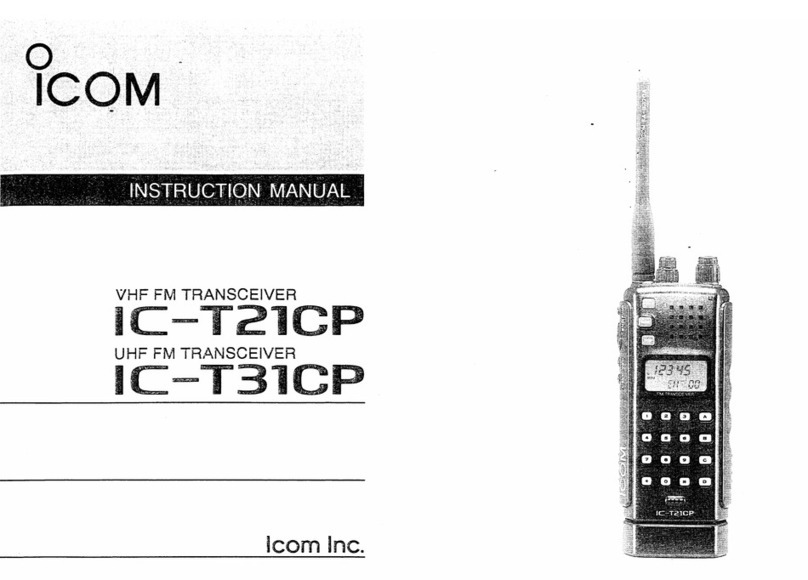
Icom
Icom IC-T21CP User manual
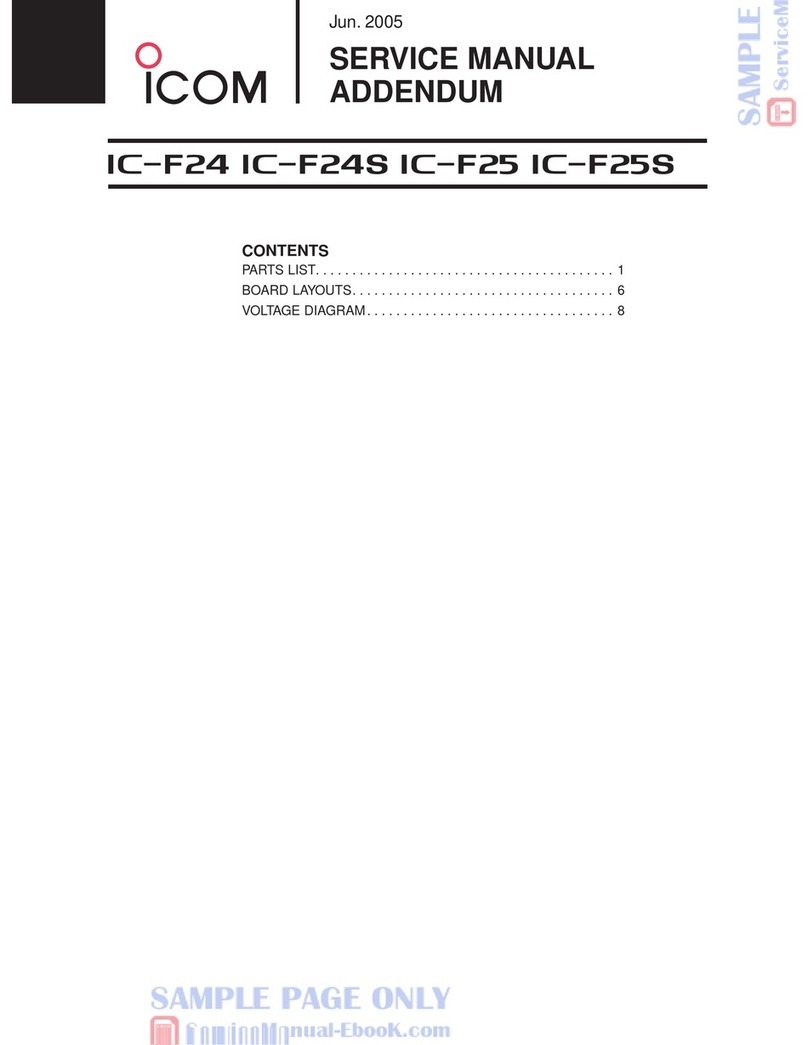
Icom
Icom IC-F24 Building instructions

Icom
Icom IC-F5360D User manual

Icom
Icom A25C SPORT 66 USA Parts list manual
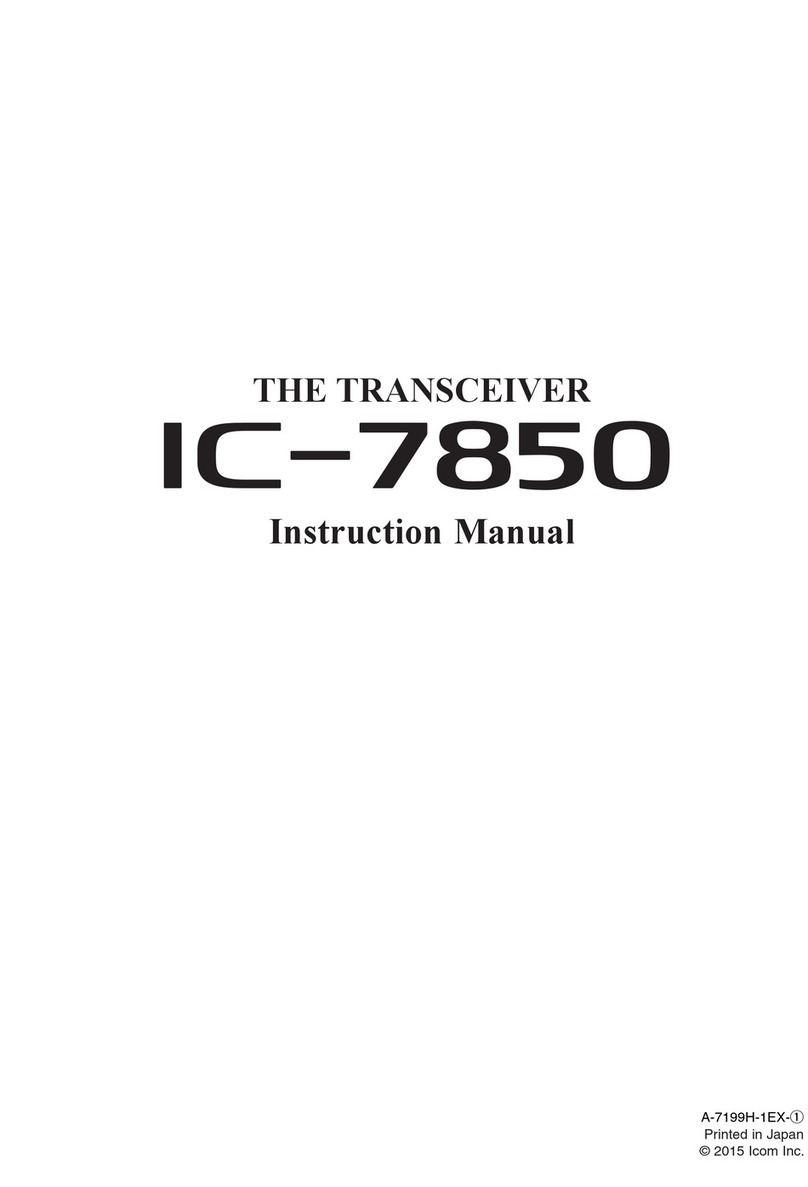
Icom
Icom iC-7850 User manual
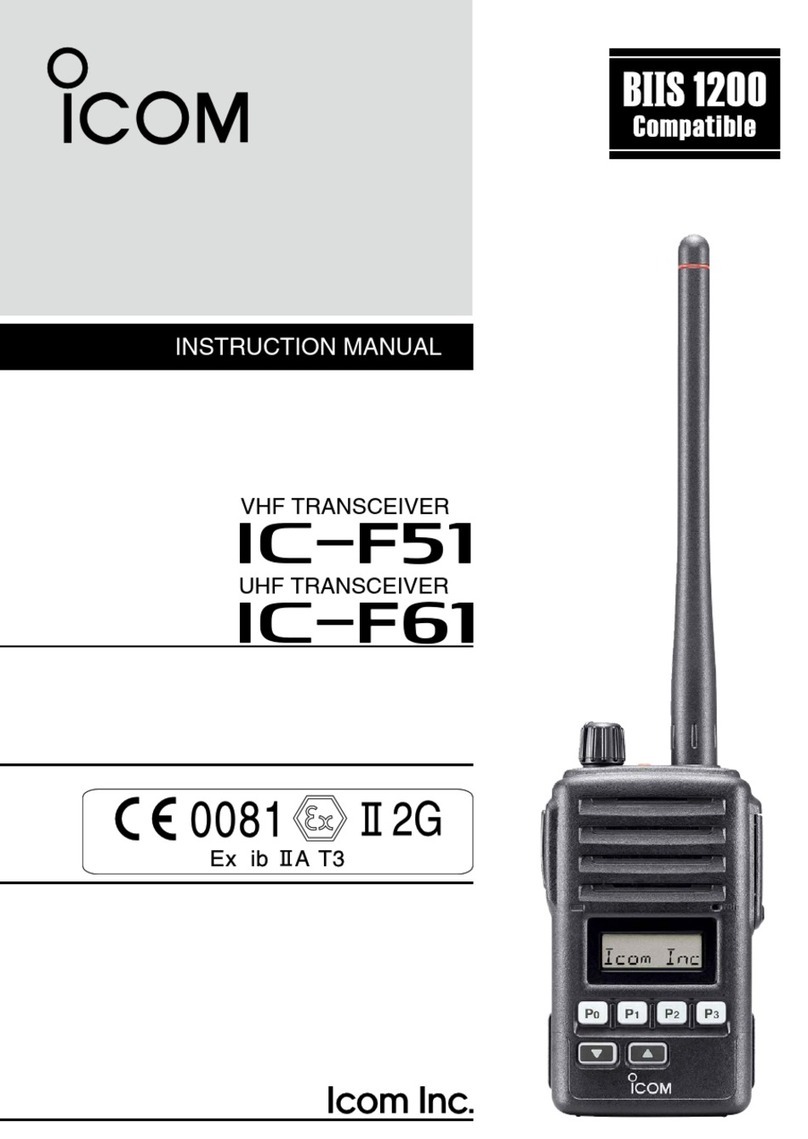
Icom
Icom IC-F51 User manual
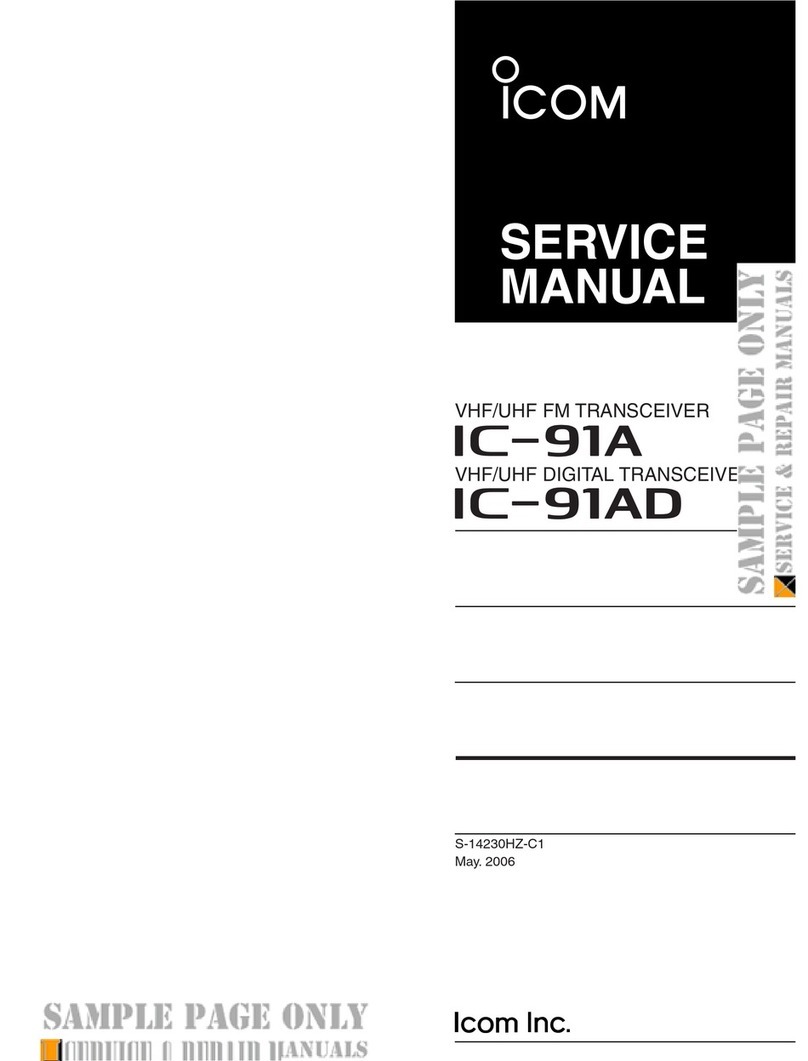
Icom
Icom IC-91A User manual
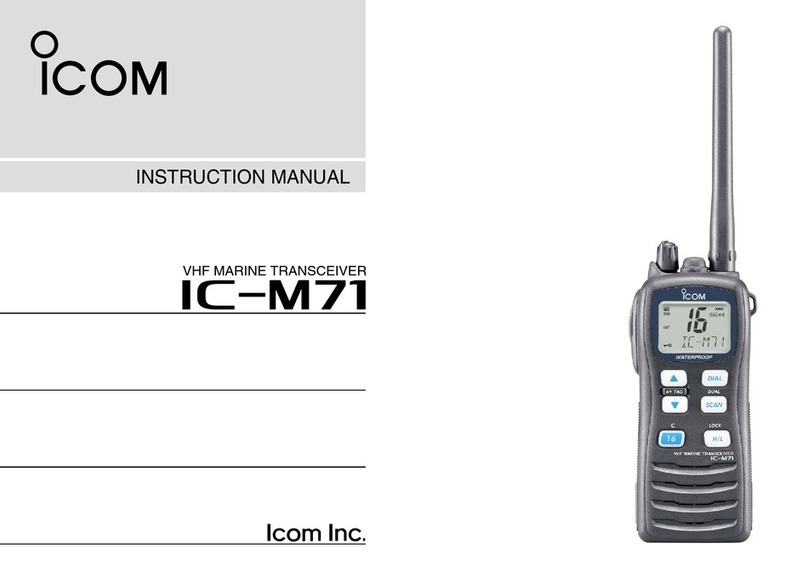
Icom
Icom IC-M71 User manual
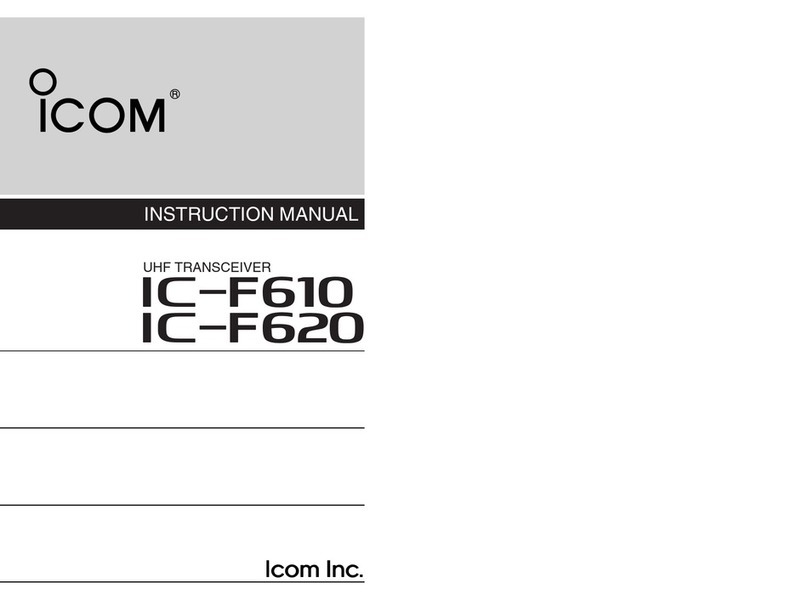
Icom
Icom IC-F610 User manual
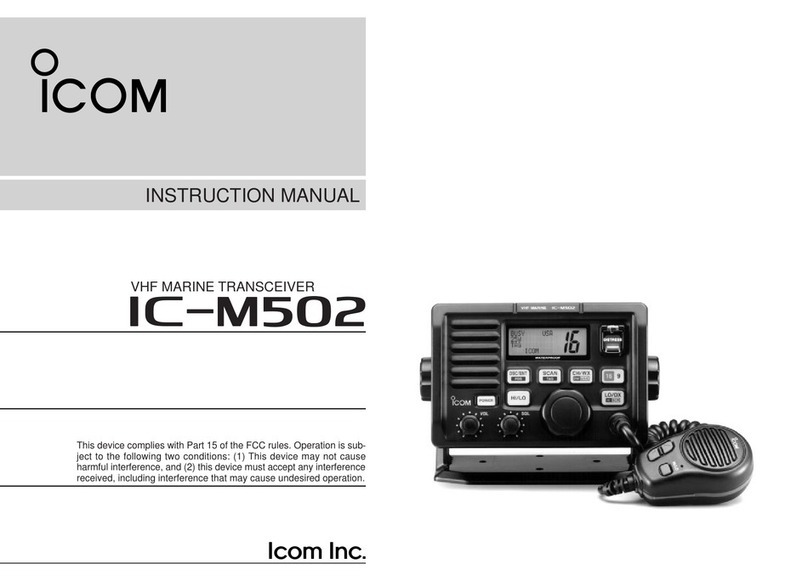
Icom
Icom IC-M502 User manual

